|
FORT PULASKI National Monument |
 |
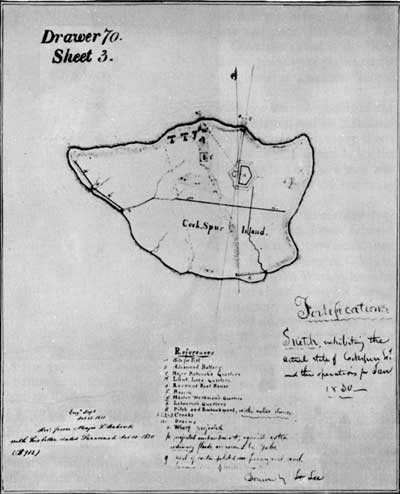
Sketch of Cockspur Island by Lt. Robert E. Lee, 1830.
The New
Fort on Cockspur
The United States can be proud of her victories in the War of 1812, but there were also defeats. It was fortunate that while England was fighting on this side of the Atlantic, her principal forces were engaged in a death struggle with Napoleon on the continent of Europe. American defenses were deplorably weak. On thousands of miles of coastline there was scarcely a fort to oppose the enemy. British troops pillaged and burned the city of Washington and laid waste to many sections along the Middle Atlantic States. This humiliating and tragic lesson soon aroused public opinion to demand strong measures for protection.
After the Treaty of Ghent in 1814, which terminated the war with Britain, President James Madison urged Congress to appropriate funds to complete all forts then under construction and to extend the system of fortifications in order that the United States might at all times be prepared to prevent or repel the danger of foreign invasion.
The task of developing entirely new and adequate fortifications along the far-flung Atlantic and Gulf coasts was one which required the direction of a military expert with special engineering abilities. The Government's search for a person peculiarly fitted for this position resulted in securing the services of the distinguished French fortification and military engineer, Gen. Simon Bernard, who was then seeking employment in the United States.

Diamondback terrapin. Sketch by Robert E. Lee, Cockspur island,
1831.
Courtesy F. B. Screven.
A graduate of the Ècole Polytechnique in Paris, Bernard had served with distinction in many of the campaigns of Napoleon. He displayed such outstanding abilities in fortification and engineering tactics that he soon acquired an enviable reputation. In 1815, after the Battle of Waterloo, he came to the United States at the suggestion of Joseph Bonaparte, bearing high recommendations to government officials from Lafayette and Albert Gallatin. With the consent of Congress, which had authorized the employment of a "skillful assistant," President Madison commissioned Bernard in the Corps of Engineers with the rank of brigadier general by brevet. Early in December 1816, by direct order of the President, General Bernard, Col. William McRee, and Col. Joseph G. Totten formed a new "Board of Engineers," the duties of which were to devise a system of seacoast defense for the entire country.
President Monroe, who succeeded Madison, was even more energetic than his predecessor in promoting the construction of new defenses. During his administration fortification policies were established, surveys were completed, and funds were provided to start construction.
Cockspur Island was chosen as the site for a new fort in March 1821, when the river approaches to Savannah were surveyed by Capt. John Le Conte under the personal supervision of Bernard, but construction on Cockspur was not begun until 1829. Plans approved by Bernard in 1827 proved to be unsuitable and a revised plan was prepared in 1831. The fort, as originally designed, was a massive 2-story structure mounting 3 tiers of guns. The deep mud of Cockspur, however, offered no foundation for so great a weight. In revising the plans, it was necessary to reduce the height of the walls and to provide heavy wooden piles and grillage to support the brick masonry.
Maj. Samuel Babcock, of the Corps of Engineers, was placed in charge of construction in December 1828, and work got under way early in the following year. Difficulty was encountered almost immediately in establishing title to the island, ownership of which was divided between private interests and the State of Georgia. In colonial days, from 4 to 20 acres on Cockspur Point had been reserved by the Crown for public use, and after the Revolution title to the Crown land became vested in the State. The two earlier forts, George and Greene, had been erected within this special reserve. The western portion of Cockspur, embracing approximately 150 acres, was granted in 1759 by George II to Jonathan Bryan, Esq., from whom it passed, through several hands, to the heirs of Edward Telfair, Governor of Georgia. On March 15, 1830, the Telfair interests were purchased by the United States for $5,000, and 15 years later the State of Georgia ceded the public lands on Cockspur Point to the Federal Government.
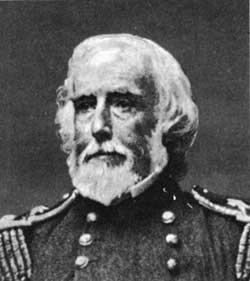 Brig. Gen. Joseph K. F. Mansfield, builder of Fort Pulaski. From The Photographic History of the Civil War. |
Late in 1829, Robert E. Lee, newly graduated from the United States Military Academy at West Point, was appointed to duty under Babcock. It was his first military assignment, Young Lee had the title of "acting assistant commissary of subsistence," but, because of his superior officer's ill health, he actually ran the job for more than a year until Babcock was succeeded by Lt. Joseph K. F. Mansfield. Lee began the system of drainage and dikes for the island. He made numerous surveys and located the permanent site for the fort. To Mansfield, however, who served on Cockspur from 1831 to 1845, belongs chief credit for construction. His great engineering ability, combined with a passionate devotion to duty, enabled him to overcome almost insurmountable difficulties to complete the fort.
In 1833, the new fort was named Pulaski in honor of the Polish hero, Count Casimir Pulaski, who fought in the American Revolution and was mortally wounded at the Battle of Savannah on October 9, 1779. While rallying French and American forces in an attack on a strong British redoubt, Pulaski was struck in the thigh by a grape shot. He died 2 days later, and, according to tradition, was buried at sea near the mouth of the Savannah River.
Work progressed at Fort Pulaski more or less continuously from 1829 to 1847, the year in which construction was essentially completed. It was an enormous project. Bricks were bought in lots of from 1 to 7 million, and it is probable that as many as 25,000,000 were put into the structure. Lumber, lime, lead, iron, and many other supplies were bought in proportionately large quantities. The rose-brown bricks, of which the walls are largely built, were manufactured at the old Hermitage Plantation 2 miles west of Savannah. The much harder, rose-red bricks in the embrasures, arches, and the walls facing the parade ground were purchased in Baltimore, Md., and Alexandria, Va. The granite was quarried in New York State and the brown sandstone in the valley of the Connecticut River. Negro slaves, rented from the owners of neighboring rice plantations, performed many of the hard labor jobs, while skilled masons and carpenters were recruited not only in Savannah but were also brought down each fall from Northern States.
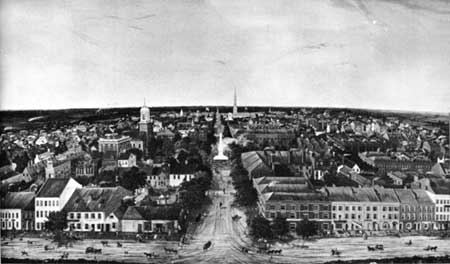
Savannah, 1837.
Tempera painting by F.
Cerveau. Courtesy Georgia Historical Society.
Throughout the long years of Mansfield's service on Cockspur Island there were many frustrating delays. There were summers in which all work had to stop because of the danger from malaria, yellow fever, typhoid, and dysentery. There were periods when Congress failed to appropriate funds. At least once, Mansfield continued to build on credit—a bold expedient, which no Government servant today would dare to follow. There were also destructive hurricanes and bone chilling winter gales. By the end of his tour of duty Mansfield was thoroughly discouraged, but through his determined perseverance he has left an enduring monument.
Nearly a million dollars had been spent on Fort Pulaski by the end of 1860, but in one respect it was not yet finished. Its armament was to include 146 guns, but only 20 guns had been mounted. Nor had the fort yet been garrisoned. At the end of 1860, its entire complement included a caretaker and an ordnance sergeant. For three decades, however, the project on Cockspur Island had served as a training ground for the Corps of Engineers, and with the exception of Major Babcock, who died in 1831, every engineer officer employed on the construction of the fort finally achieved the distinction of becoming a general in either the Confederate or the Union armies.
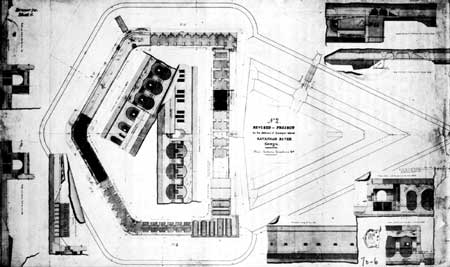
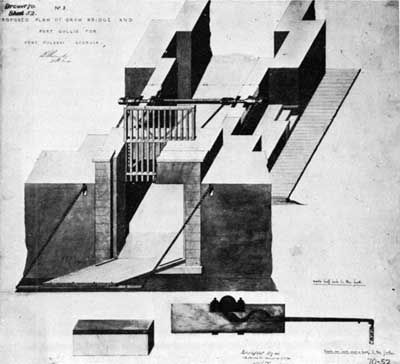
Fort Pulaski plan (top) and drawbridge plan (below).
Courtesy National Archives.

|

|
|
Last Modified: Mon, Mar 4 2002 10:00:00 pm PDT |


